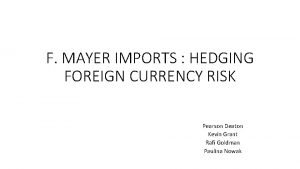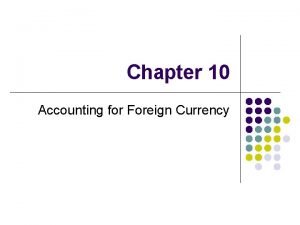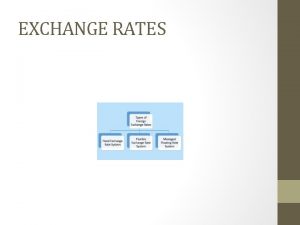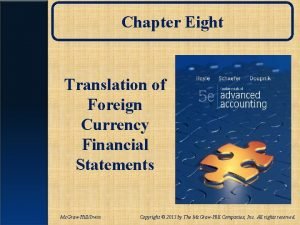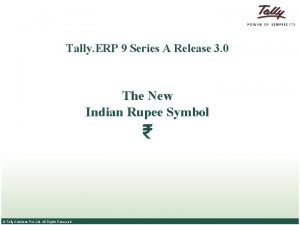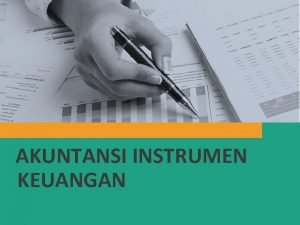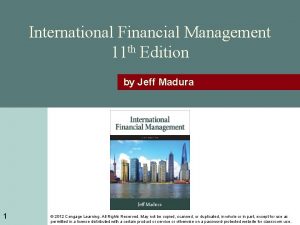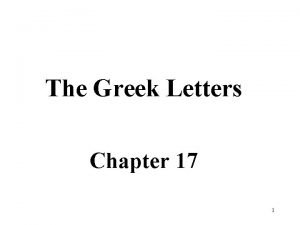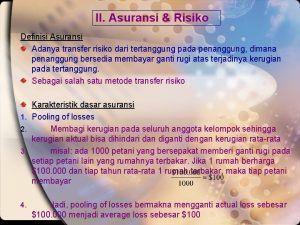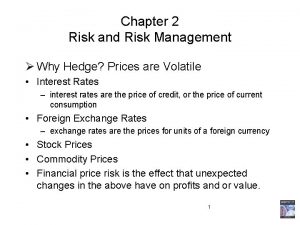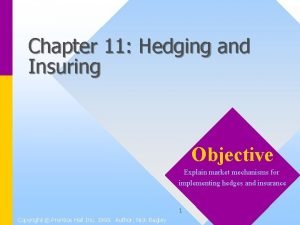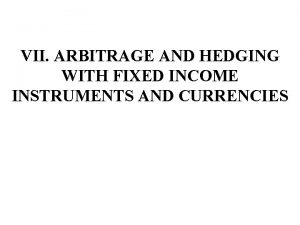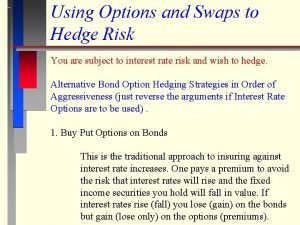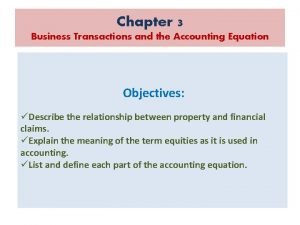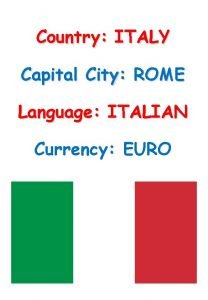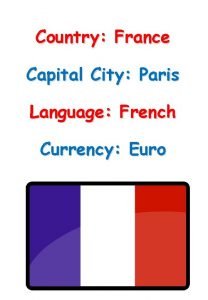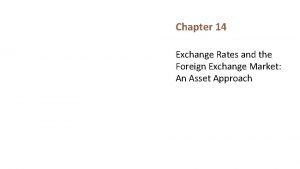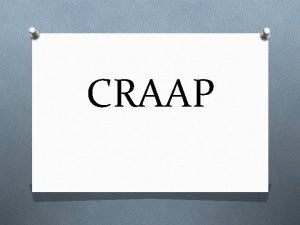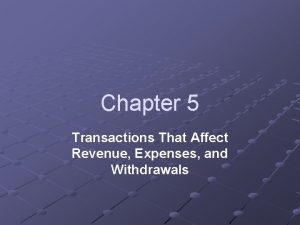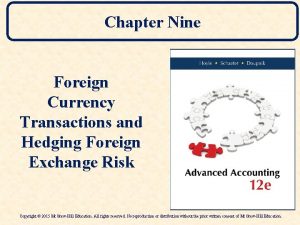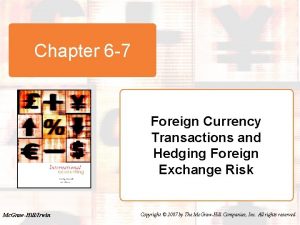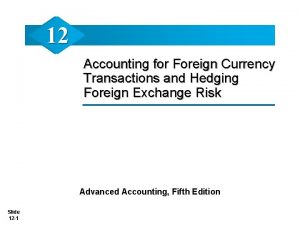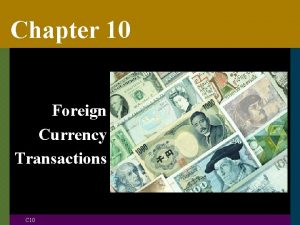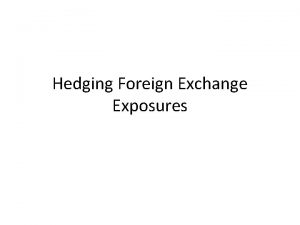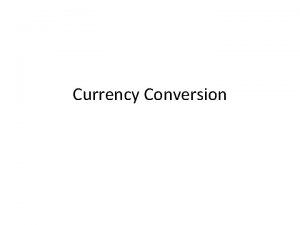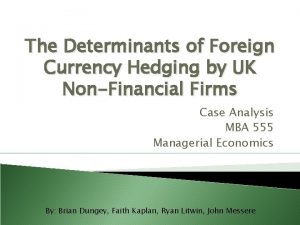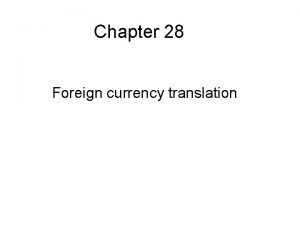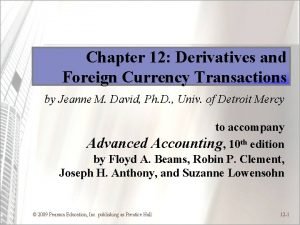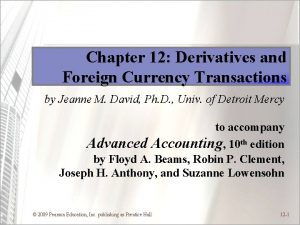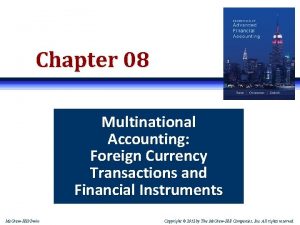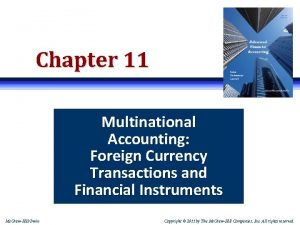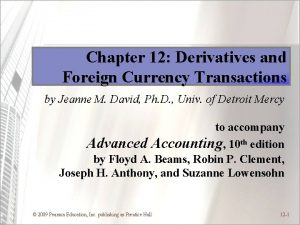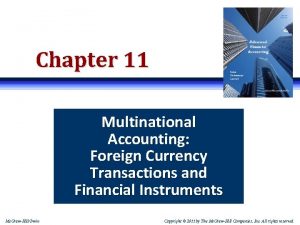Chapter Nine Foreign Currency Transactions and Hedging Foreign












































- Slides: 44

Chapter Nine Foreign Currency Transactions and Hedging Foreign Exchange Risk Copyright © 2015 Mc. Graw-Hill Education. All rights reserved. No reproduction or distribution without the prior written consent of Mc. Graw-Hill Education.

Learning Objective 9 -1 Understand concepts related to foreign currency, exchange rates, and foreign exchange risk. 9 -2

Exchange Rate Mechanisms Ø Between 1945 and 1973, countries fixed the par value of their currency in terms of the U. S. dollar. Ø The U. S. dollar was based on the Gold Standard until 1971. Ø Since 1973, exchange rates have been allowed to float in value. Ø Several currency arrangements exist. 9 -3

Different Currency Mechanisms Ø Independent Float - the currency is allowed to fluctuate according to market forces Ø Pegged to another currency - the currency’s value is fixed in terms of a particular foreign currency, and the central bank will intervene to maintain the fixed value Ø European Monetary System - a common currency (the euro) is used in multiple countries. Its value floats against other world currencies. 9 -4

Foreign Exchange Rates Ø An Exchange Rate is the cost of one currency in terms of another. Ø Rates published daily in the Wall Street Journal are as of 4: 00 pm Eastern time on the day prior to publication. Rates are also available on line at: www. oanda. com and http: //www. x-rates. com Ø The published rates are wholesale rates that banks use with each other – retail rates to consumers are higher. Ø The difference between the rates at which a bank is willing to buy and sell currency is known as the “spread. ” Ø Rates change constantly! 9 -5

Foreign Exchange Rates Spot Rate Ø The exchange rate that is available today. Forward Rate Ø The exchange rate that can be locked in today for an expected future exchange transaction. Ø The actual spot rate at the future date may differ from today’s forward rate. Ø A forward contract requires the purchase (or sale) of currency units at a future date at the contracted exchange rate. 9 -6

Foreign Exchange – Option Contracts An options contract gives the holder the option of buying (or selling) currency units at a future date at the contracted “strike” price. Ø A “put” option allows for the sale of foreign currency by the option holder. Ø A “call” option allows for the purchase of foreign currency by the option holder. Ø An option gives the holder “the right but not the obligation” to trade the foreign currency in the future. 9 -7

Option values Value is derived from : Ø A function of the difference between current spot rate and strike price Ø The difference between foreign and domestic interest rates Ø The length of time to option expiration Ø The potential volatility of changes in the spot rate ØAn option premium is a function of Intrinsic Value and Time Value 9 -8

Learning Objective 9 -2 Account foreign currency transactions using the two transaction perspective, accrual approach. 9 -9

Foreign Currency Transactions Ø A U. S. company buys or sells goods or services to a party in another country. This is often called foreign trade. Ø The transaction is often denominated in the currency of the foreign party. Ø How do we account for the changes in the value of the foreign currency? 9 -10

Transaction Exposure Export sale: Exposure exists when the exporter allows buyer to pay in a foreign currency sometime after the sale has been made. The exporter is exposed to the risk that the foreign currency might depreciate between the date of sale and the date payment is received, decreasing the U. S. dollars collected. 9 -11

Transaction Exposure Import purchase: Exposure exists when the importer is required to pay in foreign currency sometime after the purchase has been made. The importer is exposed to the risk that the foreign currency might appreciate between the date of purchase and the date of payment, increasing the U. S. dollars that have to be paid for the imported goods. 9 -12

Foreign Currency Transactions There are two methods of accounting for changes in the value of a foreign currency transaction, the onetransaction perspective and the two-transaction perspective. The one-transaction perspective assumes: 1. the export sale is not complete until the foreign currency receivable has been collected. 2. Changes in the U. S. dollar value of the foreign currency is accounted for as an adjustment to Accounts Receivable and Sales. 9 -13

Foreign Currency Transactions GAAP requires the two-transaction approach and treats the sale and collection of cash as two separate transactions. 1. Account for the original sale in US Dollars at date of sale. No subsequent adjustments are required. 2. Changes in the U. S. dollar value of the foreign currency are accounted for as gains/losses from exchange rate fluctuations reported separately from sales in the income statement. 9 -14

Foreign Exchange Transaction Example Summary of the relationship between fluctuations in exchange rates and foreign exchange gains and losses: Ø Foreign currency receivables from an export sale creates an asset exposure to foreign exchange risk. Ø Foreign currency payables from an import purchase creates a liability exposure to foreign exchange risk. 9 -15

Accounting for Unrealized Gains and Losses Under the two-transaction perspective, a foreign exchange gain or loss arises at the balance sheet date that has not yet been realized in cash. Two approaches exist to account for unrealized foreign exchange gains and losses: 1. Deferral approach: Gains and losses are deferred on the balance sheet until cash is paid or received and a realized foreign exchange gain or loss is included in income when paid. 9 -16

Accounting for Unrealized Gains and Losses 2. Accrual approach (required by U. S. GAAP): Unrealized foreign exchange gains and losses are reported in net income in the period in which the exchange rate changes. Change in the exchange rate from the balance sheet date to date of payment results in a second foreign exchange gain or loss that is reported in the second accounting period. 9 -17

Learning Objective 9 -3 Understand how foreign currency forward contracts and foreign currency options can be used to hedge foreign exchange risk. 9 -18

Hedging Foreign Exchange Risk Companies will avoid uncertainty associated with the effect of unfavorable changes in the value of foreign currencies using foreign currency derivatives. The two most common derivatives used to hedge foreign exchange risk are foreign currency forward contracts and foreign currency options. 9 -19

Hedging Foreign Exchange Risk Two foreign currency derivatives often used : Ø Foreign currency forward contracts lock in the price for which the currency will sell at contract’s maturity. Ø Foreign currency options establish a price for which the currency can be sold, but is not required to be sold at maturity. 9 -20

Accounting for Derivatives ASC Topic 815 provides guidance for hedges of four types of foreign exchange risk. 1. Recognized foreign currency denominated assets & liabilities. 2. Unrecognized foreign currency firm commitments. 3. Forecasted foreign currency denominated transactions. 4. Net investments in foreign operations 9 -21

Accounting for Derivatives The fair value of the derivative is recorded at the same time as the transaction to be hedged, based on: Ø The forward rate when the forward contract was entered into. Ø The current forward rate for a contract that matures on the same date as the forward contract. Ø A discount rate (the company’s incremental borrowing rate). 9 -22

Accounting for Derivatives In accordance with U. S. GAAP, gains and losses arising from changes in the fair value of derivatives are recognized initially either Ø on the income statement as a part of net income or Ø on the balance sheet in accumulated other comprehensive income. Recognition treatment depends partly on whether the company uses derivatives for hedging purposes or for speculation. 9 -23

Accounting for Derivatives U. S. GAAP allows hedge accounting foreign currency derivatives only if three conditions are satisfied: 1. The derivative is used to hedge either a cash flow exposure or fair-value exposure to foreign exchange risk. 2. The derivative is highly effective in offsetting changes in the cash flows or fair value related to the hedged item. 3. The derivative is properly documented as a hedge. 9 -24

Learning Objective 9 -4 Account forward contracts and options used as hedges of foreign currency denominated assets and liabilities. 9 -25

Accounting for Hedges Two ways to account for hedges of foreign currency denominated assets and liabilities: 1. Cash Flow Hedge Ø The hedging instrument must completely offset the variability in the cash flows associated with the foreign currency receivable or payable. Ø Gains/losses are recorded in Accumulated Other Comprehensive Income. 2. Fair Value Hedge. Ø Any other hedging instrument. Ø Gains/losses are recognized immediately in net income. 9 -26

Accounting for Hedges Cash Flow Hedge At the balance sheet date: 1. The hedged asset or liability is adjusted to fair value based on changes in the spot exchange rate, and a foreign exchange gain or loss is recognized in net income. 2. The derivative hedging instrument is adjusted to fair value (an asset or liability on the balance sheet) with the counterpart recognized as a change in Accumulated Other Comprehensive Income (AOCI). 9 -27

Accounting for Hedges Cash Flow Hedge continued. . . At the balance sheet date: 3. An amount equal to the foreign exchange gain or loss on the hedged asset or liability is then transferred from AOCI to net income to offset any gain or loss on the hedged asset or liability. 4. An additional amount is removed from AOCI and recognized in net income to reflect (a) the current period’s amortization of the original discount or premium on the forward contract (if it is the hedging instrument) or (b) the change in the time value of the option (if it is the hedging instrument). 9 -28

Accounting for Hedges Fair Value Hedge At the balance sheet date: 1. Adjust the hedged asset or liability to fair value based on changes in the spot exchange rate and recognize a foreign exchange gain or loss in net income. 2. Adjust the derivative hedging instrument to fair value (resulting in an asset or liability reported on the balance sheet) and recognize the counterpart as a gain or loss in net income. 9 -29

Foreign Currency Option as a Hedge An option is a contract that allows you to exercise a predetermined exchange rate if it is to your advantage. As with forward contracts, options can be designated as cash flow hedges or fair value hedges. Option prices are determined using the Black-Scholes Option Pricing Model covered in most finance texts. 9 -30

Learning Objective 9 -5 Account forward contracts and options used as hedges of foreign currency firm commitments. 9 -31

Foreign Currency Firm Commitment Hedge A firm commitment is an executory contract normally recognized in financial statements; the company has not delivered goods nor has the customer paid for them. When a firm commitment is hedged using a derivative financial instrument, hedge accounting requires explicit recognition on the balance sheet at fair value of both the derivative financial instrument and the firm commitment. 9 -32

Foreign Currency Firm Commitment Hedge Changes in the spot exchange rate are used to determine the fair value of the firm commitment when a foreign currency option is the hedging instrument. U. S. GAAP allows hedges of firm commitments to be designated either as cash flow or fair value hedges. 9 -33

Foreign Currency Firm Commitment Hedge Options are carried at fair value on the balance sheet of both the derivative financial instrument (forward contract or option) and the firm commitment. The change in value of the firm commitment gain/loss offsets the gain or loss on the hedging instrument. Gain/loss is recognized currently in net income, as is the gain/loss on the firm commitment attributable to the hedged risk. 9 -34

Learning Objective 9 -6 Account forward contracts and options used as hedges of forecasted foreign currency transactions. 9 -35

Hedge of a Forecasted Foreign Currency Denominated Transaction Cash flow hedge accounting may be used foreign currency derivatives associated with a forecasted foreign currency transaction. The forecasted transaction must be probable, highly effective, and the hedging relationship must be properly documented. There is no recognition of the forecasted transaction or gains and losses on the forecasted transaction. 9 -36

Hedge of a Forecasted Foreign Currency Denominated Transaction The company reports the hedging instrument (forward contract or option) at fair value, but changes in the fair value of are not reported in net income. Gains and losses on the hedging instrument are recorded in Other Comprehensive Income until the date of the forecasted transaction then transferred to net income on the projected transaction date. 9 -37

Learning Objective 9 -7 Prepare journal entries to account foreign currency borrowings. 9 -38

Foreign Currency Borrowings Companies often must account foreign currency borrowings, another type of foreign currency transaction. Companies borrow foreign currency from foreign lenders to finance foreign operations or to take advantage of more favorable interest rates. The facts that the principal and interest are denominated in foreign currency and create an exposure to foreign exchange risk complicate accounting for a foreign currency borrowing. 9 -39

Journal Entries 9 -40

Foreign Currency Borrowings Companies also lend foreign currency to related parties, creating the opposite situation from a foreign currency borrowing. The company must keep track of a note receivable and interest receivable, both of which are denominated in foreign currency. Fluctuations in the U. S. dollar value of the principal and interest generally give rise to foreign exchange gains and losses that would be included in income. 9 -41

IFRS—Foreign Currency Transactions and Hedges There are no substantive differences between U. S. GAAP and IFRS in accounting foreign currency transactions. Similar to U. S. GAAP, IAS 21, “The Effects of Changes in Foreign Exchange Rates, ” requires the use of a two-transaction perspective in accounting foreign currency transactions with unrealized foreign exchange gains and losses accrued in net income in the period of exchange rate change. 9 -42

IFRS—Foreign Currency Transactions and Hedges IAS 39, “Financial Instruments: Recognition and Measurement, ” governs accounting for hedging instruments including those used to hedge foreign exchange risk. One difference between the two sets of standards relates to the type of financial instrument designated as a foreign currency cash flow hedge. U. S. GAAP allows only derivative financial instruments to be used as a cash flow hedge. IFRS allows nonderivative financial instruments. 9 -43

IFRS—Foreign Currency Transactions and Hedges In 2010, the IASB proposed a new hedge accounting model that would result in significant differences between IFRS and U. S. GAAP. In 2012, the IASB issued a draft of a forthcoming statement that would move hedge accounting from IAS 39 to IFRS 9, “Financial Instruments, ” to implement the new model which would go into effect in 2015. IFRS 9 is intended to more closely align accounting with a company’s risk management activities. 9 -44
 F mayer imports case study solution
F mayer imports case study solution Foreign currency accounting
Foreign currency accounting Foreign currency exchnage
Foreign currency exchnage Foreign currency translation example
Foreign currency translation example Rupee symbol in tally
Rupee symbol in tally Hedging strategies using futures
Hedging strategies using futures Too foreign for home
Too foreign for home Fed tapering
Fed tapering Hedging and boosting
Hedging and boosting Hedged item and hedging instrument examples
Hedged item and hedging instrument examples Hedging receivables and payables
Hedging receivables and payables Tailing the hedge
Tailing the hedge Hedging in writing
Hedging in writing Vega greek
Vega greek Formality in academic writing exercises
Formality in academic writing exercises Hedging adalah
Hedging adalah Hedging in academic writing
Hedging in academic writing Hedging adalah
Hedging adalah Cautious language examples
Cautious language examples Hedging manages risk that are manageable
Hedging manages risk that are manageable Main objective of hedging
Main objective of hedging Hedging strategies using futures
Hedging strategies using futures Oil hedging definition
Oil hedging definition Cattle hedging strategies
Cattle hedging strategies Pengertian instrumen derivatif
Pengertian instrumen derivatif Long hedge and short hedge
Long hedge and short hedge Hedging interest rate risk with futures
Hedging interest rate risk with futures Hedging approach of working capital
Hedging approach of working capital Imperfect hedge
Imperfect hedge Fixed income hedging
Fixed income hedging Hedging credit risk with options
Hedging credit risk with options Hedging adalah
Hedging adalah Futures contract example
Futures contract example Static hedging of exotic options
Static hedging of exotic options Problem 3-1 balancing the accounting equation
Problem 3-1 balancing the accounting equation Rome capital and currency
Rome capital and currency Paris france language
Paris france language Appreciation and depreciation of currency
Appreciation and depreciation of currency Timeliness example news
Timeliness example news Currency and timeliness
Currency and timeliness Accuracy authority objectivity currency and coverage
Accuracy authority objectivity currency and coverage Currency futures and options
Currency futures and options What factors affect region/community location decisions
What factors affect region/community location decisions Part one—analyzing accounting concepts and procedures
Part one—analyzing accounting concepts and procedures Chapter 5 transactions that affect
Chapter 5 transactions that affect
